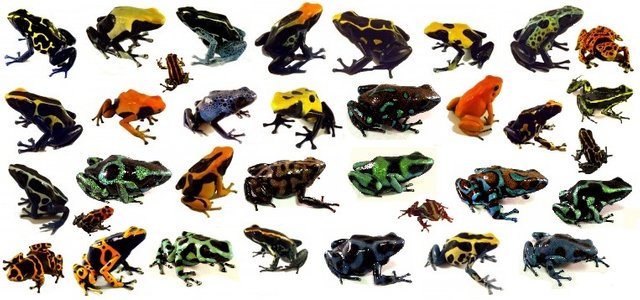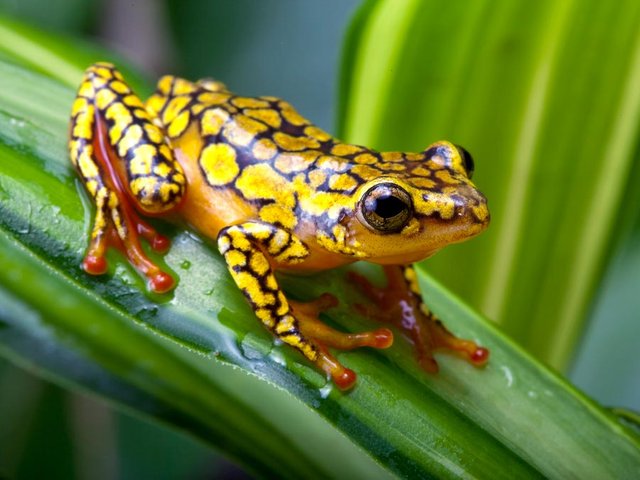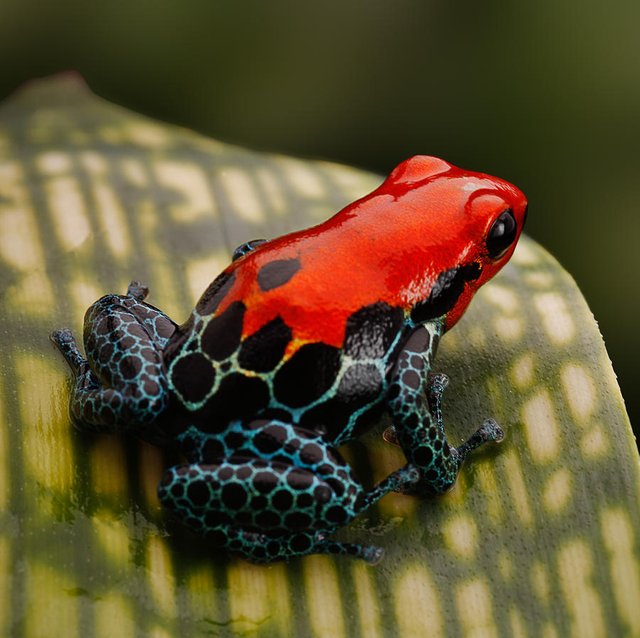Poisonous Frogs Face Higher Extinction Risk
When it comes to the natural world, being toxic can be a big benefit. The ability to produce poison or venom significantly decreases the likelihood that other animals will dine on you, drastically increasing your own ability to survive. On the individual level, poison-producing animals are more likely to survive to reproduce successfully, however a new study has revealed that toxin production could run counter to the continuation of the entire species. Poisonous frogs, like the poison dart frogs, may face higher extinction risks due to their chemical defenses.

Dr. Kevin Arbuckle's latest study (published in the journal Royal Society Open Science), has revealed that poisonous species are 60% more likely to be endangered or threatened than species that don't produce toxins. This stat is particularly worrisome as amphibians already face a higher rate of extinction than most other groups of animals, with one out of every three species at risk of extinction. Various animal characteristics can be linked to contemporary extinction risk, such as traits that influence factors like mortality rates or the ability for a species population to recover after experiencing a decline. As a result, many of these traits and characteristics can be used as reliable predictors of extinction risk.

Using amphibians as a model system, Dr. Arbuckle investigated if their chemical defenses is associated with contemporary extinction rates. He compared their conservation statuses (endangered, vulnerable, threatened, etc) against those of species that did not employ chemical defenses. What he found was that these toxic amphibians often faced a greater threat of extinction.
"The results of this new study suggest that while toxic defense can be great for avoiding predators, it might be bad news in the long-term for a species. It's another example of how evolution doesn't act 'for the good of the species', but instead for the good of the individual." -Arbuckle (Source)

Dr. Arbuckle believes his research may be useful in determining the future conservation statuses of amphibians.
"The results also suggest that how a species defends itself might be part of the puzzle of working out which species are in need of conservation efforts." -Arbuckle (Source)
In other words, if we can positively determine that poison-producing species are more likely to face contemporary extinction risks, we be able to adjust their conservation status accordingly and begin affording these species the protection they need. But Dr. Arbuckle also points out that while we can recognize a correlation between chemical defenses and extinction risk, we still aren't sure what the link(s) is (are) between the two.
"The study builds on my previous work, which found that toxic amphibians were also more likely to become extinct over their evolutionary history, and the next step is to figure out what mechanism is behind the link between defense and extinction." -Arbuckle (Source)

He has predicted three possible explanations for the higher risk of extinction on these animals (now the subject of another study).
- The chemical defense may be too energetically costly
- Chemical defenses often allow shifts to marginal habitats with a lower carrying capacity; these habitats by their very nature are more vulnerable
- Chemical defenses are often associated with animals that have slow life histories, which negatively impacts the recovery of populations following a decline

Article Link: https://www.sciencedaily.com/releases/2016/11/161122192901.htm
Great article, very interesting!
I am not sure if I should agree here. I actually do agree with the theory of The Selfish Gene by Richard Dawkins, but successful genes (or combinations of genes) do not only contribute to the success of a single individual but also (as a side effect) to the success of the whole species (at least in case that they are included in the DNA of all members of the species).
On the other side, if genes (or combinations of them) harm the success of the species they only can do that because they also harm the success of the single individual: because if all single individuals of the species would profit (lived longer, had more descendants), then the species would be more successful as a whole, too.
The situation is different of course, if only a few (not all) members of a population display a certain gene (or combination of genes): in this case the few affected single individuals can be either more or less successful than the species as a whole.
Your explanation of species evolution is accurate but I think you are misunderstanding the quote because you actually agreed with it. Yes, the success (or failure) of a species is driven by evolution, like you mentioned, but AS A SIDE EFFECT. Evolution isn't driven on the species level, it takes place on the individual level (which then impacts the population, and later, the species as a whole). Evolution is a series of adaptations on the level of a single organism, affecting how that organism survives; it is not driven by what the species will need one day in the future (if that makes sense).
The quote is slightly misleading. He doesn't mean that evolution doesn't EVENTUALLY act for the good of the species (because it does), but it DIRECTLY acts for the good (or harm) of the individual (which again later impacts the species).
I hope my explanation isn't too confusing. I think the quote taken out of context is a bit tricky but like I said, I think what you are trying to say goes along the same lines the author meant. I would chalk it up to an over-simplification.
Thanks for the comment!
Yes, maybe. I understood his sentence in a way that he would think a certain gen can harm the species but at the same time help the single individual to succeed (but then, if the individuals succeed, finally the species as a whole will succeed, too - at least if enough individuals of this species have the "successful" gene).
But I just read the sentence again, and probably you are right and I just misunderstood its meaning! (I am not a native English speaker.)
By the way: nice to read your articles about reptiles and amphibians.
Thank you! And I think you made a fine point, your reasoning was sound.
It is possible that a gene can be beneficial on the individual level but harmful in the long term for the species as a whole (that's what the article is about after all). The dart frogs poison is a great defense to the individual frog, ensuring that they won't be eaten. However, for some reason (as they haven't yet pinpointed the exact cause), this seemingly beneficial defense seems to be hindering the species as a whole. It'll definitely require some further studies to understand exactly what is happening.
So yes, the gene is good for the individual (better defense) but for some reason it is harming the population (part of the reason why I find this study so fascinating is because that definitely runs counter to most of our notions of evolution: if the individual is benefiting, why does the species suffer?).
Exactly! Part of the problem is we often deem an adaptation as simply good or bad...when more often than not, each one has its advantages and disadvantages. It all just depends on how the adaptation affects the individual.
Very cool synopsis! I look forward to learning the results of these hypothesis tests!
I will be seeing some Golden Frogs this weekend I hope. They are definitely a threatened species. Panama has some amazing colors of frogs. Just the other day a blue one hopped across the road in front of our truck. I stopped and let the little guy pass. It was only about the size of a quarter.